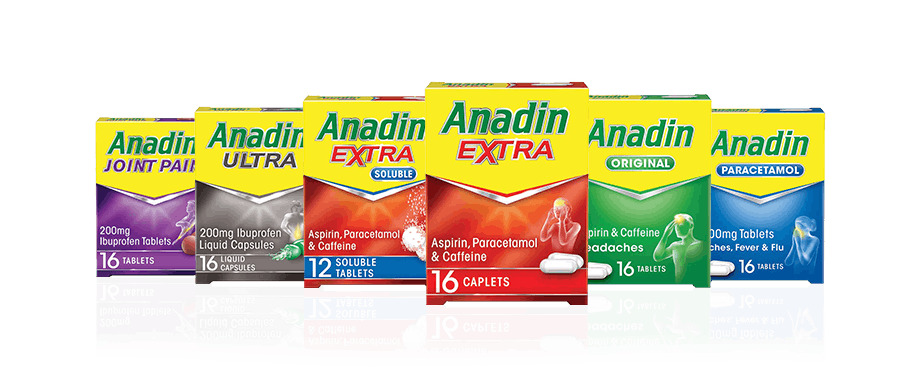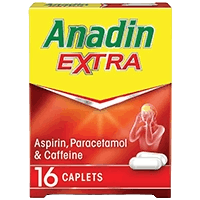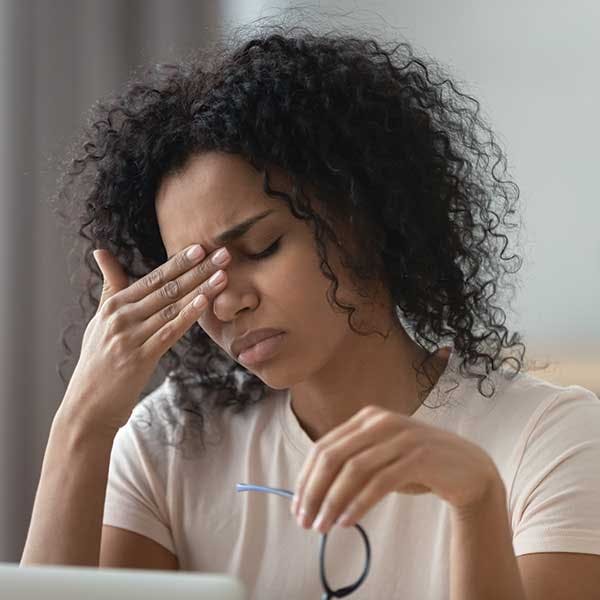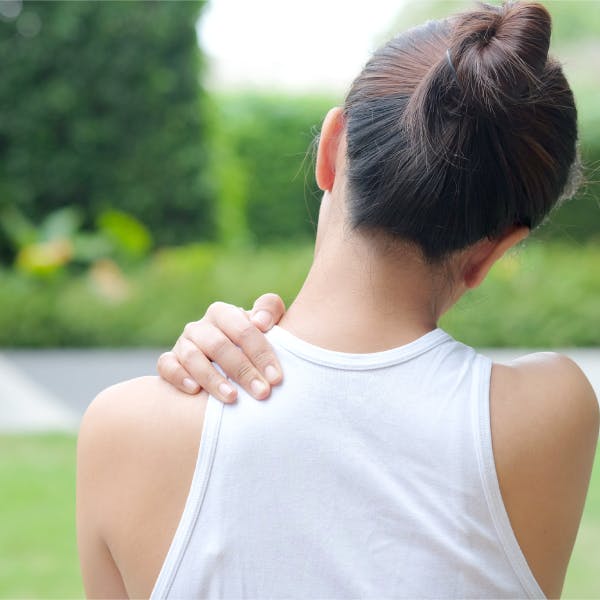Aspirin + Caffeine
Aspirin + Paracetamol + Caffeine
Anadin Extra Tablets Anadin Extra Soluble Tablets
Paracetamol
Neck pain can be caused by simple issues like bad posture, such as sitting at a desk for a long time or sleeping in an awkward position, or more serious issues like an injury or a pinched nerve.
Below, find out what can trigger neck pain, whether neck strain can cause headaches, and ways to prevent your neck from hurting.
Types of Neck Pain
Common types of neck pain and their symptoms include:
- Muscle pain: There are more than 20 muscles connected in the neck and stretching them too far can cause small tears in the neck muscles, tendons, and the connective tissue between the two. This can sometimes cause pain, inflammation, and swelling.
- Spasms: Neck muscle spasms can feel like tightening, throbbing, twitching, or cramping – all of which are unpleasant and can impede your ability to carry out day-to-day activities like driving or generally focusing on tasks.
- Joint pain: Neck joint pain and inflammation can be caused by injury or longer-lasting conditions such as arthritis or sprains or strains.
- Nerve pain: Slipped spinal discs can pinch nerves in the neck and lead to nerve pain. In this event, you may even experience weakness or numbness in your arms; at which point you should seek immediate medical assistance from a healthcare professional.
- Bone pain: Osteoporosis (a health condition that weakens bones over several years) in the spine can cause bone pain, which can affect the neck.
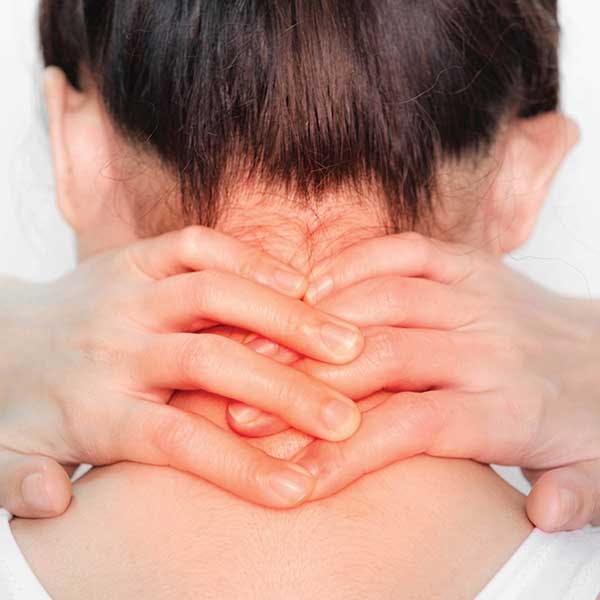
Neck Pain Causes
- Poor posture: Slumping over our desks and mobile phones can lead to neck strain - coined “tech neck”. Tilting your head downwards for long periods can lead to neck spasms, headaches, and problems with shoulder joints.
- Sleeping position: Many of us sleep with multiple stacked pillows. However, one low firm pillow is best for your neck, resting your head at the same height as the rest of your body.
- Injuries: Whiplash, falling over, and sports injuries are common causes of neck pain. If you’ve had an accident that has caused neck strain that doesn’t go away after a few weeks or is very painful, please speak to a healthcare professional.
What Does it Mean if I Have Neck Pain and a Headache?
Neck pain can lead to aches in other parts of the body, like your head, shoulders and back. Neck pain and headaches can often occur at the same time as neck problems can strain the nerves in the neck, resulting in a headache.
Tension headaches and migraines as a result of stress or anxiety can tighten neck muscles and contribute to neck pain.
If your symptoms are intense or persistent, please see a healthcare professional.
Treatment of Neck Pain
Mild neck pain from sprains, pulled muscles, or sleeping in an uncomfortable position can be eased with pain relief medication.
The Anadin ibuprofen range – which includes Anadin Joint Pain Tablets and Anadin Ultra Capsules ease neck joint aches, body pain and inflammation.
For more serious or prolonged pain, be sure to see a healthcare professional to get advice on the cause of your neck pain.
Of course, neck pain related to injuries and health conditions can’t always be prevented. However, if the root of your pain comes down to poor posture, sleeping position, or other lifestyle choices, there are things you can change to prevent and relieve your neck aches.
Preventing Neck Pain
- Improve your posture: Stand and sit up straight with your shoulders rolled back, and keep your chin up, with devices held straight out instead of bending your neck downwards.
- Upgrade your workspace: It’s often thought that sitting upright in a desk chair is best for your back, shoulders and neck – but that’s not the case. A 25-30° recline is optimal, tilting your body slightly backwards from the screen. This allows your neck muscles to relax. A good rule is that your neck should be in a position where your head would fall backwards if you fell asleep.
- Take breaks: It’s vital to get up and move frequently, especially if you have a sedentary job. Ideally, you want to stand up and walk around – even just for a minute – every 15-30 minutes to get your blood flowing and muscles moving.
- Sleep well: Try switching to just one pillow and make sure your mattress is firm and supportive.
Exercises for Neck Pain
Exercises to help with neck problems are key to tissue healing and building up movement and strength. If any of the below exercises cause too much discomfort, stop immediately and see a healthcare professional for advice.
1. Head Turns
Start with your head facing forward. Then, gently turn your head to the left, keeping your body facing forward. You should feel a stretch on the right side of your neck. Hold for 2 seconds. Return to facing forward. Repeat by turning your head to the right.
2. Side-to-Side Head Tilts
Begin by sitting or lying on your back with your head and body facing forward. Next, tilt your head sideways, so your ear reaches towards your shoulder. Hold for 2 seconds, then return to where you began. Repeat on the other side.
3. Forward Head Tilts
Start by facing forwards. Then, bend your neck downwards, chin towards chest – this gently stretches the back of the neck. Hold for a few seconds, then slowly bring your head back up.
4. Shoulder Stretch
Sit or stand with your arms bent at a right angle at the elbow, so your hands are in front of you, palms up. Next, keeping your upper arms at your sides, move both hands out sideways until your left hand is pointing to the left and your right hand is pointing to the right. Hold this pose for a few seconds and then bring your arms back to the starting position.
Neck Pain FAQs
How do I know if my neck pain is serious?
Neck pain that persists for more than a few weeks, doesn’t get better with painkillers, or is accompanied by other symptoms like numbness in the arms, should be assessed by a healthcare professional to check for any underlying causes.
How to sleep with neck pain?
Your sleeping position has a big impact on your neck. Accidentally sleeping with your neck locked into an awkward position can result in neck pain. To reduce the risk of this happening, use a firm mattress and sleep with only one firm, low pillow to avoid neck strain while sleeping.
Should I use ice or heat for neck pain?
This depends on the cause of pain. Always speak to a healthcare professional if you’re not sure.
In general, it is best to use ice for injuries that are less than six weeks old. This is because heat can increase inflammation, while ice reduces it as well as numbs pain and minimises bruising by constricting blood vessels.
If you’re suffering from arthritis pain in your neck, moist heat works best, such as soaking in a warm bath.
Neck spasms can be treated by placing a heat pack or a warm moist towel on the neck.
Cooling a headache caused by neck pain can be achieved with ice or a cool pack over your forehead and temples.
As with any new injury, use an ice pack on a neck muscle sprain to reduce inflammation. Once you’re sure that the sprain isn’t inflamed, switch to soothing aching muscles by applying heat.


